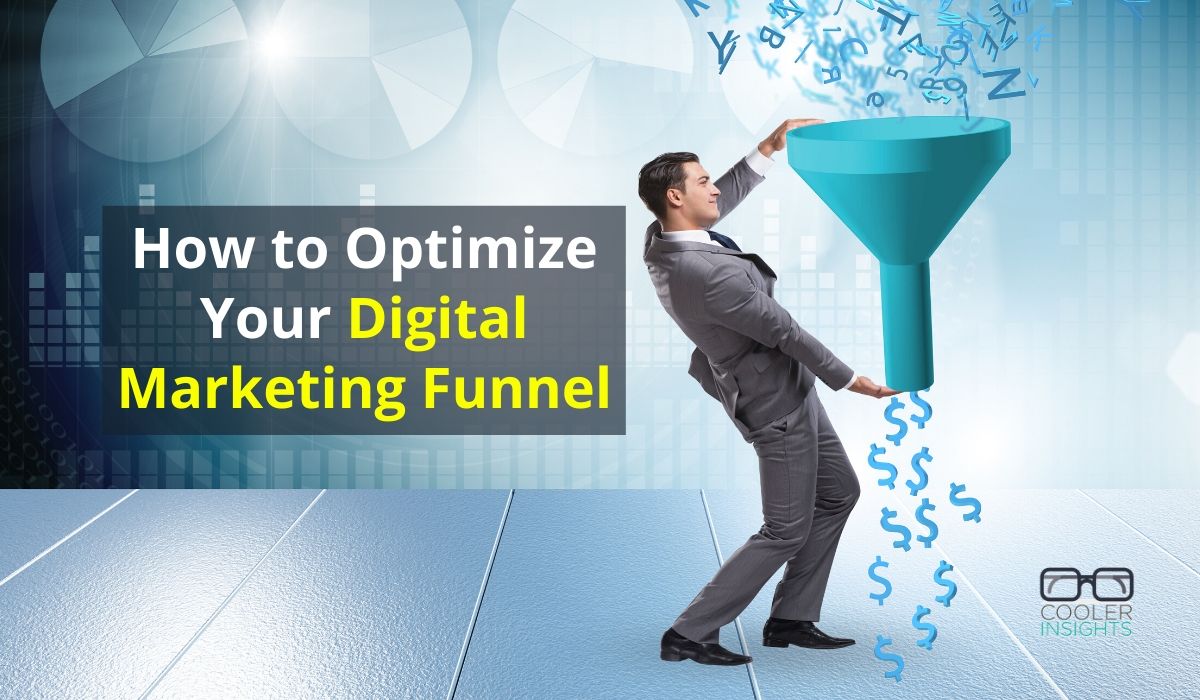
Do you know what a digital marketing funnel is? Or how you can set up one to measure your digital marketing goals and customer purchase journeys?
First, know this: You can monitor and measure every single step of your marketing process! And the best way to do so is to develop your own digital marketing funnel.
If you are familiar with a traditional marketing funnel, you’d have no problems working with a digital marketing funnel.
Like the former, a digital marketing funnel helps you to analyse how well your customer conversion process is performing. From awareness to consideration to conversion to loyalty and finally advocacy. It also traces your customer’s buying journey and maps them along each step of the way.
Before we dive into the details of a digital funnel, let us first look at what it is, and why you need to build one.
What is a Digital Marketing Funnel?
A digital marketing funnel is the series of online content channels which a user encounters as they move through different stages in their relationship with your brand:
- Awareness: The initial phase where your user is a viewer, visitor or fan
- Consideration: A deeper phase where they’ve started to engage with your brand online
- Conversion: The step where they become your lead, prospect, and later customer
- Loyalty: When your customer decides to deepen their investment in your brand
- Advocacy: When your customer becomes a brand ambassador and helps spread the word
Also known as a sales funnel, a digital marketing funnel often involves a process of lead nurturing and customer cultivation, and it looks at your entire customer buying journey.
Why You Need a Digital Marketing Funnel
There are many reasons for building a digital marketing funnel.
First, you need to understand that your potential customers do not simply buy when they see the first ad that you’ve published online. On the contrary, it may take as many as 6 to 8 interactions (the Rule of 7) before they whip out their credit cards or get ready to sign a contract with you.
Next, a digital marketing funnel helps you to keep tabs on your marketing analytics at various steps of your customer relationship. This allows you to develop a systematic way of monitoring, tracking and optimizing your digital marketing channels, and determine how well your ads, social media posts, blog articles, landing pages, offers, emails, and instant messages are performing.
Thirdly, a digital marketing funnel gives you a better view of your customer throughout the entire lead and customer nurturing process. Rather than create haphazard pieces of content and hope to get “big numbers,” a funnel allows you to build and sustain a relationship with your prospect and customer throughout their entire customer journey.
Here’s how such a funnel could possibly look like, complete with various content types that may work.
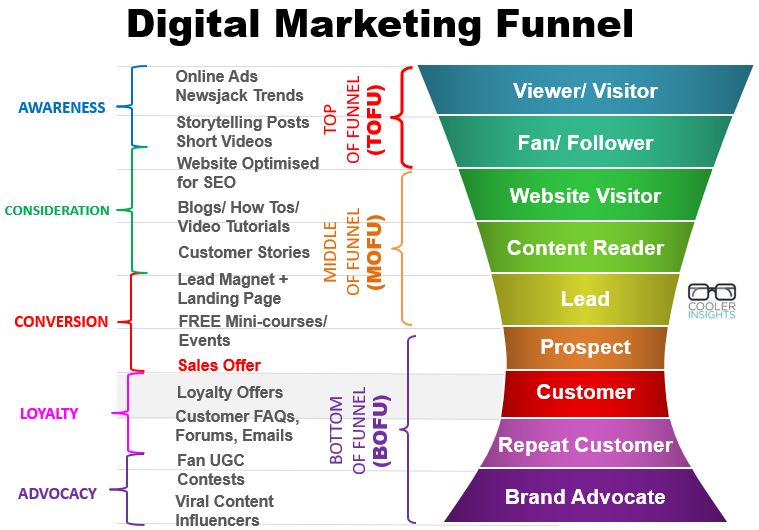
Using tools like Google Analytics, Kissmetrics, or marketing automation software like Marketo, HubSpot, and Infusionsoft, it is possible to continually streamline and optimize your digital marketing process.
Let us take a closer look at how this entire process works.
Mapping Your Customer’s Buying Journey
Before you construct your digital marketing funnel, you need to identify the different stages of your customer’s buying journey.
This would typically cover the following:
- Need Recognition: What do I need to acquire? What are my wants or desires? What is the pain that I wish to solve?
- Research Options: What options are available to me? Which is the best way to resolve my issues?
- Evaluate Brands: How do I know which option is best? What methods can I use to compare them?
- Purchase: I’m almost there in making a buying decision. However, are there factors that will persuade me further?
- Post-Purchase: How was my experience like with the brand? Will I recommend this to my friends?

In a sense, these 5-stages roughly map out to the different perception levels of a potential customer with your brand—from Awareness, Consideration, Conversion, Loyalty and Advocacy, as shown below.
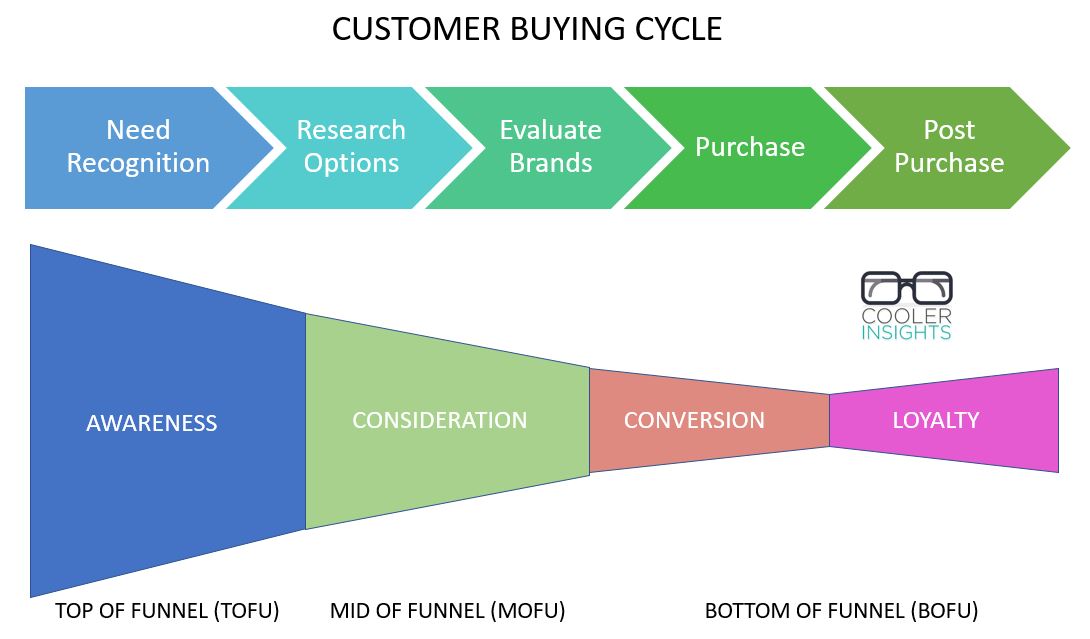
When we turn the funnel around, it would look like the version which I’ve shown you earlier. Beyond the different stages, a digital marketing funnel would have the following:
- Content Types: These would vary depending on the goal at the different stages of a funnel. For example, generating awareness may require more current trending content, whereas fostering loyalty may require more one-to-one channels like emails and specific customer offers.
- Customer Stages: As you can see, the different levels of the funnel would have different categories of a potential customer – from a viewer or visitor to a fan/follower/subscriber to a website visitor, content reader, lead, prospect, customer, repeat customer and brand advocate. This is in order of increasing value to your company.

Digital Marketing Funnel Tools and Channels
A digital marketing funnel (or sales funnel or marketing funnel) captures the different points of entry of your target audience to a web page or social media post.
This is normally divided into three sections:
- Top of the funnel (TOFU)
- Middle of the funnel (MOFU)
- Bottom of the funnel (BOFU)
Your goal is to “graduate” your online visitors to move progressively downwards towards a profitable action like an online purchase or signing up for a programme. This process is called lead nurturing
Let us take a closer look at the funnel, with my example below:
Top Of Funnel (TOFU)
Also known as TOFU (Asians will have no problems remembering this!), the top of your digital marketing funnel is where the bulk of your visitors first encounter your online brand.
As shown in the diagram above, most of these visitors arrive at your website (or landing page) through the following actions:
- Search Engine Optimization (SEO) – They searched for specific terms or keywords which your website ranked for, and clicked on the link provided by a search engine.
- Social Media Marketing (SMM) – They were attracted by a social media post (eg Facebook, LinkedIn, Twitter, etc), and clicked on the link shared.
- Pay Per Click (PPC) Advertising – They clicked on an online advertisement on Google’s network (AdWords or Display Ads), a Facebook Ad (eg sponsored post), or other social media/online ads.
The key here is to attract the most relevant and interested parties to visit your website or landing page. To do so, generate and share short but helpful content such as blog articles, infographics, and slides which address specific customer pain points or needs.
(PS – You may want to advertise some of your best content by boosting them on social media.)
Note that we normally do not ask for the sale at this stage. This is because your TOFU web visitors are likely to be fairly “cold” to your products or services.
However, you can introduce specific Calls To Actions (CTAs) to convert TOFU visitors to MOFU leads. This may include encouraging them to opt-in with their contact information for more valuable and helpful content like an eBook, slide, or template.
Middle Of Funnel (MOFU)
Unlike TOFU visitors, folks who hover around the MOFU layer are normally more invested in their relationship with you.
Often, they are the more valuable leads who have decided to opt-in by providing their contact details (normally name, email address, organisations and occasionally mobile numbers) on what we call a lead page.
In return, they will receive a valuable piece of longer-form content or a tool. Also known as a lead magnet, examples of such lead-nurturing content include the following:
- eBooks – These are the gold standard for MOFU content for professional services like management consultancy, IT, or financial services.
- Tools and Templates – Everybody loves a downloadable “plug-and-play” template which they can use for their business. Tools like calculators or auto-updated spreadsheets are also valuable.
- Webinars or Seminars – Learning opportunities like these not only provide immense value to your leads – they also allow you to promote and sell your products or services.
- White Papers – These are more theoretical and academic than eBooks, and normally include some research findings.
- Videos – Normally instructional in nature, opt-in videos could be offered as a “free sample” of a full course which you offer, or provide a valuable “DIY” tip to your users.
At this stage, you are looking at building a strong community who opt to subscribe to your email newsletter and receive updates from you.
After they have been “warmed up” sufficiently as a beneficiary of your content marketing efforts, you may want to convert them to become actual customers.
Which brings us to the next stage of lead nurturing – BOFU.
Bottom Of Funnel (BOFU)
The Bottom Of Funnel (BOFU) is where the rubber meets the road.
After you have attracted a strong following of leads and prospects who follow you religiously, you need to find the opportunity to convert them to become customers. This is where email marketing or perhaps remarketing or retargeting of your prospects could come in.
Often, an attractive offer which is highly targeted and relevant hits the sweet spot – the “Buy Now” button on your email, lead page or website.
What strategies can you apply to convert your leads to customers?
- Free trials – These are popular with providers of online software (aka Software As A Service or SAAS). The usual duration is a 30-day free trial, where you “hook” your user in populating his or her content on your platform. Once the trial period is up, a credit card account would be needed to pay for continued use of the service.
- Online assessments – Free diagnostic tools like website audits or psychological tests help to draw your customers in by offering them real value for free. However, the next steps (ie engaging your services to rectify the faults detected in the assessment) are usually paid.
- Discount coupons – Everybody loves a good deal. Timed to create a sense of scarcity, these deals normally offer a significant discount to make it attractive for users to buy.
- One-to-one consultations – For higher priced services or products (eg legal services or purchasing a car), a face-to-face consultation or actual physical test-driving helps to move a prospect to buy.
Note that getting your leads and prospects to become your customers alone isn’t enough.
Expert marketers know that managing customer experience is critical to long-term digital marketing success. Adopting a holistic view of your customer helps you to improve customer loyalty and lifetime value, giving you permission to upsell products and services to them.
Beyond this, you may also want to encourage your best customers to become your Word Of Mouth (WOM) advocates, especially on social media. You can start by giving them a small incentive (eg discounts off purchases) to involving them in designing your product. Read 9 Ways to Build Relationships on Social Media to further learn how you can socialise your digital marketing efforts.
Digital Marketing Funnel Metrics & Analytics
Learned to attract your target audiences, turn them into leads, and convert them to customers and advocates? Good!
Now you need to track, measure and optimize your digital marketing performance throughout your sales and marketing funnel. This is where digital marketing analytics using tools like Google Analytics comes in.
Let’s revisit our digital marketing funnel and add a layer of metrics and analytics.
For the example above, you can see that different measurements are needed for audiences at different stages of engagement with your brand. Using these, you can measure your marketing ROI or find ways to optimize your marketing performance.
Top Of Funnel Metrics
At the TOFU level, there are two key metrics for you to consider:
- Awareness and reach: social media reach, ad impressions (usually measured in thousands of views), and keyword searches.
- Visitorship and views (either on your website, landing page, or social media page).
Normally, the numbers who “bounce” off your website (ie leave after viewing only one page) is an indication of how “sticky” your content is. The lower the bounce rate, the higher your chances to converting your visitors to become readers.
Middle Of Funnel Metrics
This brings you to the MOFU level of the funnel. Here, the key metrics used could be defined as:
- Content readers: web visitors who spend a longer time on your website (eg 2 minutes or longer). This can be easily tracked with Google Analytics or other analytics software.
- Leads: those who choose to opt-in via a form.
Bottom Of Funnel Metrics
Finally, at the BOFU level of the funnel, you need to track the following:
- Prospects: the folks who not only subscribed to your email newsletters, but clicked through on an offer.
- Customers: leads or prospects who actually responded to your offer by completing the purchase process.
- Repeat Customers: customers who make two or more purchases of your product or service.
- Advocates: customers – and sometimes non-customers but fans – who helped to spread your content on their own social networks.
Analysing and Improving Funnel Performance
From the example given above, you can see that a reach of say 100,000 impressions yielded 100 sales conversions (ie 0.1%).
While this number may appear small, you need to consider the value of your product. 100 sales of a $1,000 high-end software product equates to $100,000 in revenue!
More importantly, you can tweak and optimize each stage of the funnel to deliver the best conversion results. A conversion is defined as a desired action, and could include any of the following:
- Increased click-through rates for ads and social shares
- Reduced bounce-rates
- Increased opt-in rates
- Increased email response rates
- Increased customer purchase rates
- Increased frequency and value of repeat purchases
- Increased number of advocates
All of these improvements will help to increase the ROI of your digital marketing efforts.
(To learn more, do also read my essential guide to Social Media Marketing ROI.)
Using Google Analytics (or Other Tools) to Track Marketing Funnel Performance
Now that you have learned about the different levels of your digital marketing funnel, your next step involves setting it up.
A good tool to do so would be Google Analytics. This free tool allows you to establish conversion goals for each stage of your funnel and track your customer “flow” from one level to another.
An example of how this is visualised is shown below (courtesy of Fast Company):
By using a tool like this, you can better determine where the gaps or “leakages” from your funnel are, and how you can fix your leaky funnel.
To learn how you can set up Google Analytics to establish goals for each stage of your funnel, watch the video below from the good guys from Kissmetrics:
Beyond Google Analytics, most marketing automation suites will have detailed analytics covering the entire customer journey. A comprehensive funnel analytics tabulation will cover the entire customer journey, from awareness to consideration to conversion to loyalty/ advocacy.
Ready to Have Fun with Digital Marketing Funnels?
Hope that my brief guide above gave you a basic understanding of how you can use digital marketing funnels to define, measure and optimize your digital marketing funnels.
Naturally, this isn’t the only way to look at funnels – there are hundreds of different variations. However, the key principles of funnel analysis remains the same.
Need Help to Build Your Digital Funnels?
With 73 clients and over 4,700 trainees, we have the knowledge and experience to help you succeed online. Fill in the contact form below to arrange for a free 30-minute Skype or Zoom consultation session!

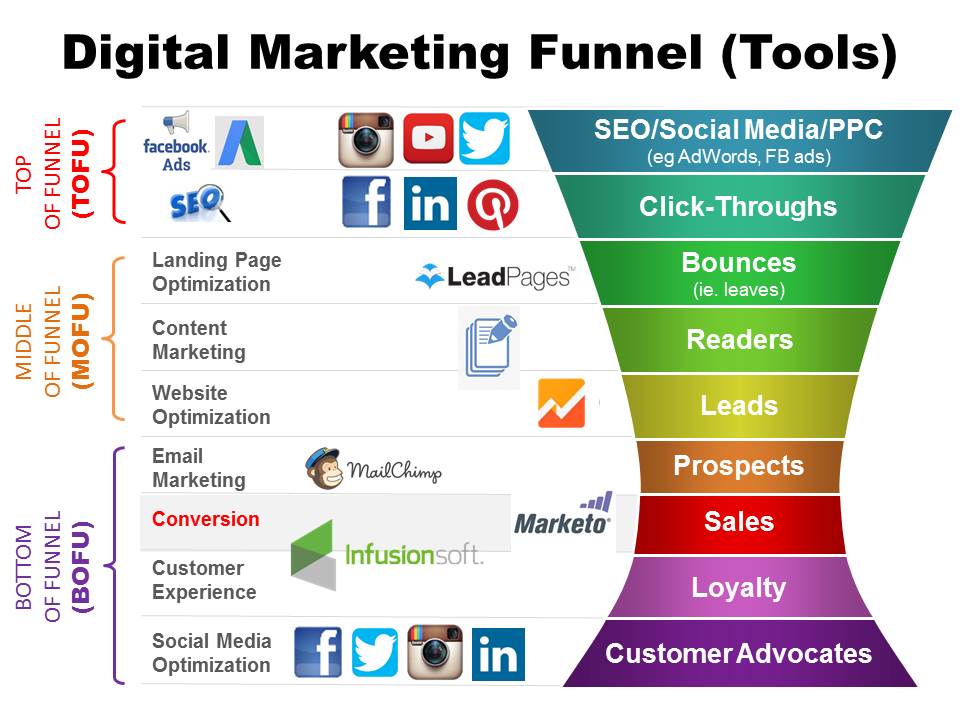
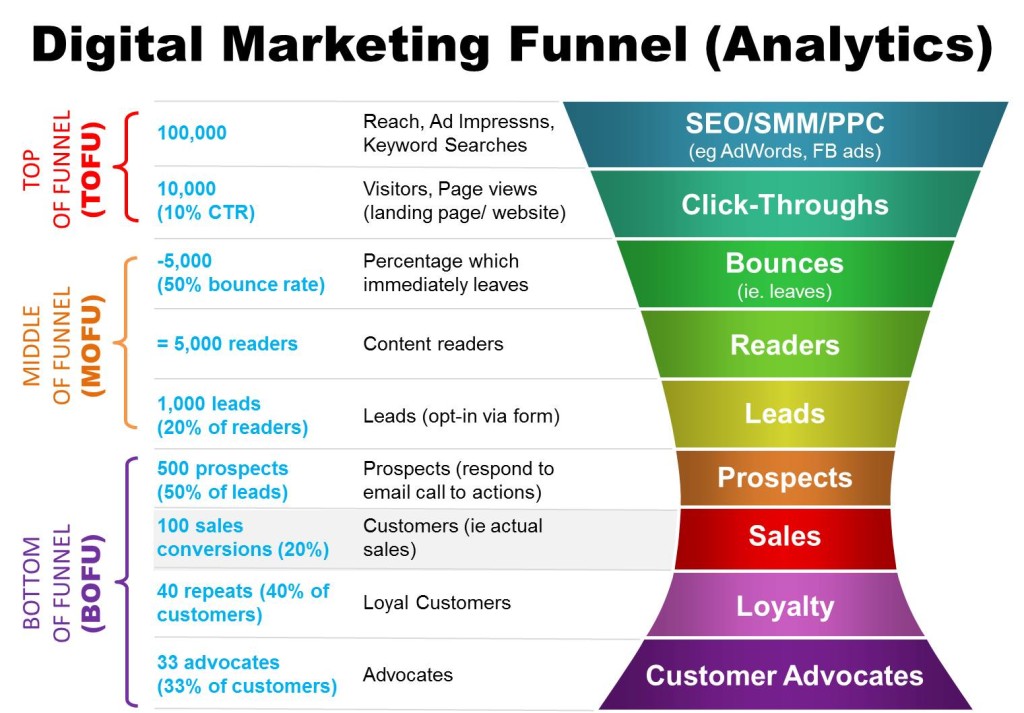
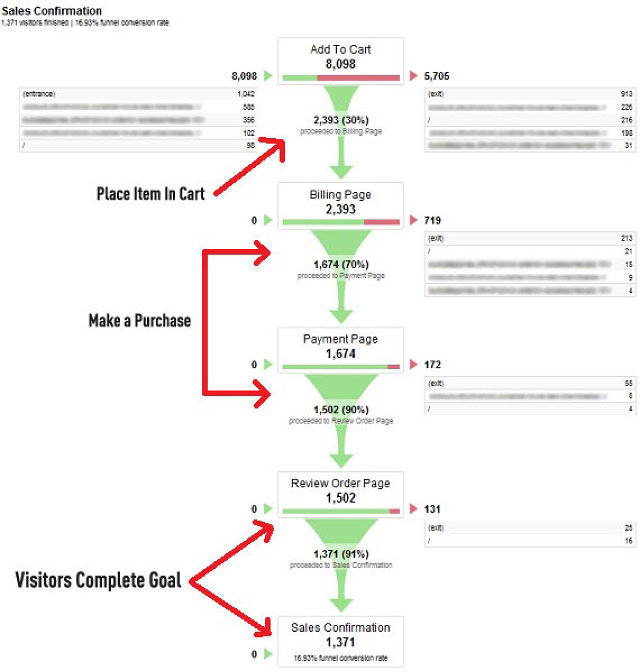
Good and usefull sharing
Could you list all the Digital Marketing Tools and from the diagram?
The digital marketing landscape is changing so quickly that it can be hard to keep up Unfortunately, as more and more marketers and businesses take up a digital marketing approach it is predicted that the cost of Facebook and Instagram advertising will rise over the coming year. Digital reviews are becoming increasingly important as consumers consider these to be authentic reviews of your product/service by ‘real’ people. Videos marketing help build trust and interest amongst your audience. The more trust and interest you can build the more likely your audience will purchase from you.
very useful
Very nice Keep it up….
Wow everything nicely Explain thanks share with us……
Digital marketing is so important in 2020 because it starts brings clients In bulk, overall it was a good article. so for everyone who is reading out this comment please start optimizing your Digital marketing funnel.
Very informative
very use full for my seals funnel bussness thank you so much for this
SO helpful – put a clear visual to concepts I’ve always had an abstract understanding of. Thank you!! Saving to reference for the foreseeable future!!!